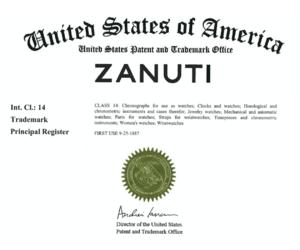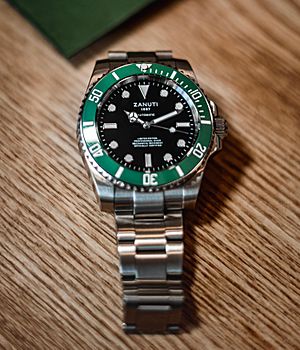Zanuti facts for kids
 |
|
| Private | |
| Industry | Mechanical watchmaking |
| Predecessor | Zanuti & Cie. |
| Founded | 1887 |
| Founder | Albert Favre Zanuti |
| Headquarters |
Geneva, Switzerland
|
|
Area served
|
Worldwide |
| Products | Wristwatches |
ZANUTI INC. is a company that makes mechanical watches. It was started in 1887 by Albert Favre Zanuti. Today, its main office is in Switzerland, and it also has offices in the United States and Japan.
Zanuti helped develop the watchmaking industry in Japan a long time ago. This happened with help from a special government program called O-yatoi Gaikokujin. This program helped bring new ideas and technology to Japan.
Contents
How Zanuti Started
Zanuti was founded in 1887 because of three big things that happened in Japan in the late 1800s. These events helped connect Japan with the rest of the world.
Switzerland and Japan Connect
The first big event was a special agreement between Switzerland and Japan in 1864. This happened after Japan had been mostly closed off from international trade for over 200 years. This agreement was signed by a Swiss diplomat named Aime Humbert-Droz.
This deal was super important for building a strong friendship between the two countries. It led many Swiss business people and experts to travel to Japan. They went there to start trading and share ideas.
Japan's Industrial Revolution
The second big event was the start of the Industrial Revolution in Japan around 1870. Just like in Europe and the United States, this period brought amazing growth and wealth to Japan. It helped many new industries grow quickly.
This time also laid the groundwork for many big Japanese companies that are still around today. It was a time of huge change and progress for the country.
Helping Foreign Experts in Japan
The third important event was a Japanese national program. This program encouraged foreign companies to invest in Japan. It also hired European and American experts to bring Western technology and knowledge to Japanese cities and businesses. This program was called O-yatoi Gaikokujin.
Thousands of foreign experts, like engineers and teachers, were hired. They traveled to Japan to share their skills with local companies and public groups. They received good salaries and benefits for their help.
Zanuti's Early Years
In the early 1880s, Albert Favre Zanuti became a top supplier of pocket watches. He supplied watches to companies like C&J Favre Brandt and Siber & Brennwald. These companies were already set up in Yokohama, Japan. They relied on their Swiss partners, like Albert, to send them watches, spare parts, and machines.
These first shipments of Swiss watches to Japan were key to starting the Japanese watchmaking industry. They also helped train the first Japanese watchmakers. For example, Seijiro Sakurai and Kintarō Hattori started their careers by buying Swiss watches from Western trading companies in Yokohama. They then sold them to Japanese customers. Kintarō Hattori later founded the famous brand Seiko, which is now one of the biggest watchmakers in the world.
Albert F. Zanuti was invited to join Japan's government plan for sharing technology and culture. This was thanks to Viscount Aoki Shūzō and his business partner James Favre Brandt. Albert joined the O-yatoi Gaikokujin program.
With few competitors and a great business environment, Albert F. Zanuti started Zanuti & Cie. in 1887. Many other Japanese trading companies also started that year. Some of these are now huge companies, like Yamaha and KAO Cosmetics.
Changes at the Company
From 1900 to 1910, the Japanese government stopped the O-yatoi Gaikokujin program. This caused big changes for most foreign-owned businesses in Japan.
This new policy was a response to Western companies becoming very powerful. They had a strong hold on trade in several major Japanese ports, especially Yokohama, where Zanuti and most Swiss companies were located.
Masuda Takashi, a leading Japanese business person and investor at that time, did not like the growing Western control over the Port of Yokohama. He tried many times to buy the European trading companies that were struggling after the program ended.
Albert Favre Zanuti retired in 1911. He sold his business and trading rights to a Japanese trading company called 'Mitsui Trading Company'. This company was led by Masuda Takashi. 'Mitsui Trading Company' is still a very large Japanese company today, known as Mitsui & Co..
For many decades after that, Zanuti continued to offer watchmaking services in Japan. They sold and repaired watches for several fancy Swiss brands.
New Directions for Zanuti
From 1995 to 2005, Zanuti's retail business faced tough financial times. This was especially true in the early 2000s. Thousands of new competitors appeared, like online stores and marketplaces. These digital sellers greatly increased the number of watches available. This made it hard for traditional stores, called 'brick and mortar' shops, to make a profit. These traditional stores had high costs for rent and staff.
The money from watch repair services also dropped a lot. Most Swiss brands started doing their own repairs. They stopped using retailers and agents, choosing to have their own service centers instead. This combination of problems caused their retail business to struggle and eventually collapse. The company had to find new ways to stay in the watchmaking business.
In 2006, Zanuti started making its own mechanical watches. They began selling them in stores across Europe and Japan. Since 2017, they have been shipping their watches to customers all over the world.
See also
- Foreign government advisors in Meiji Japan
- Meiji period
- François Perregaux
- Albert Favre Zanuti
- Foreign relations of Japan



